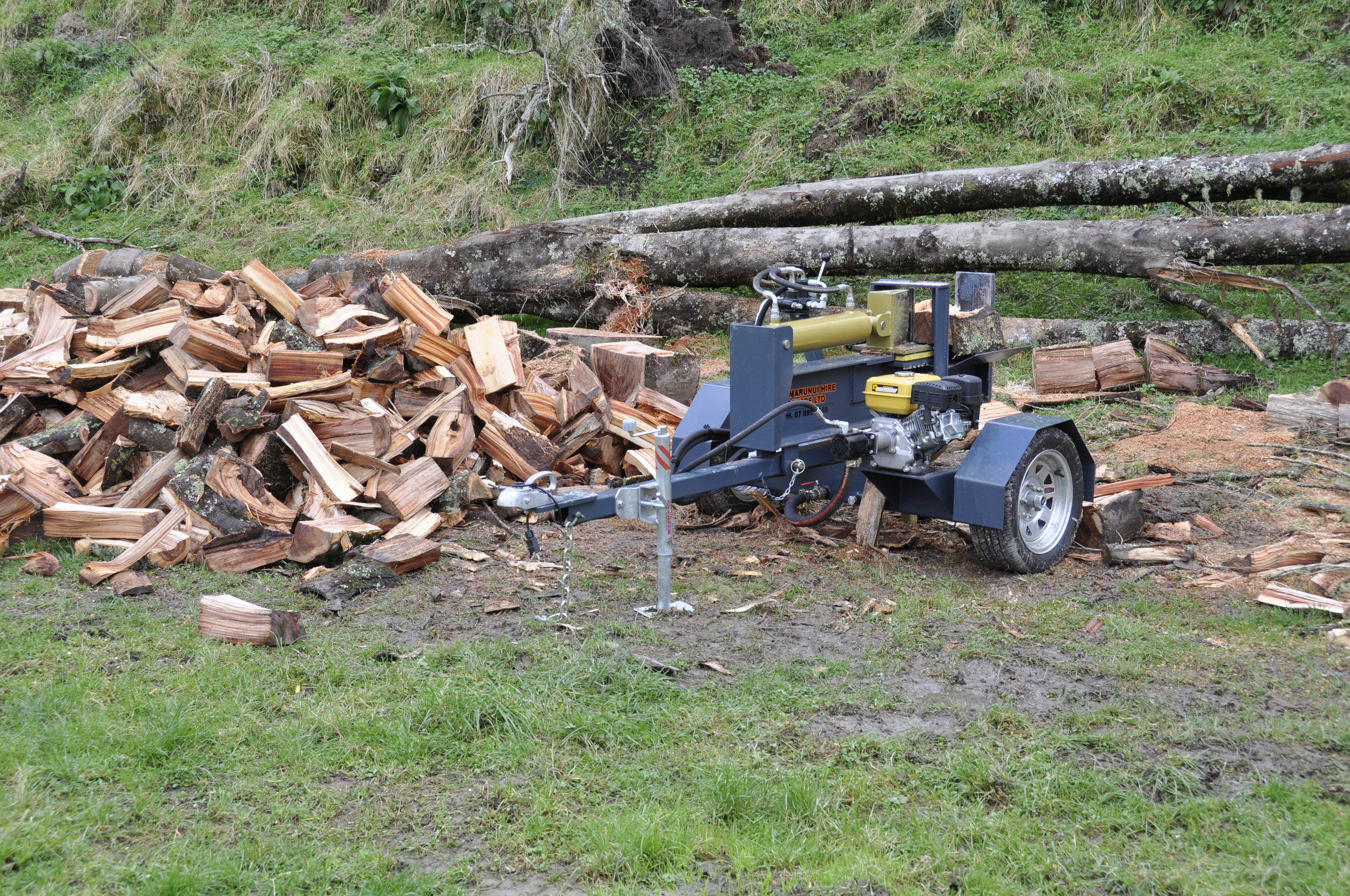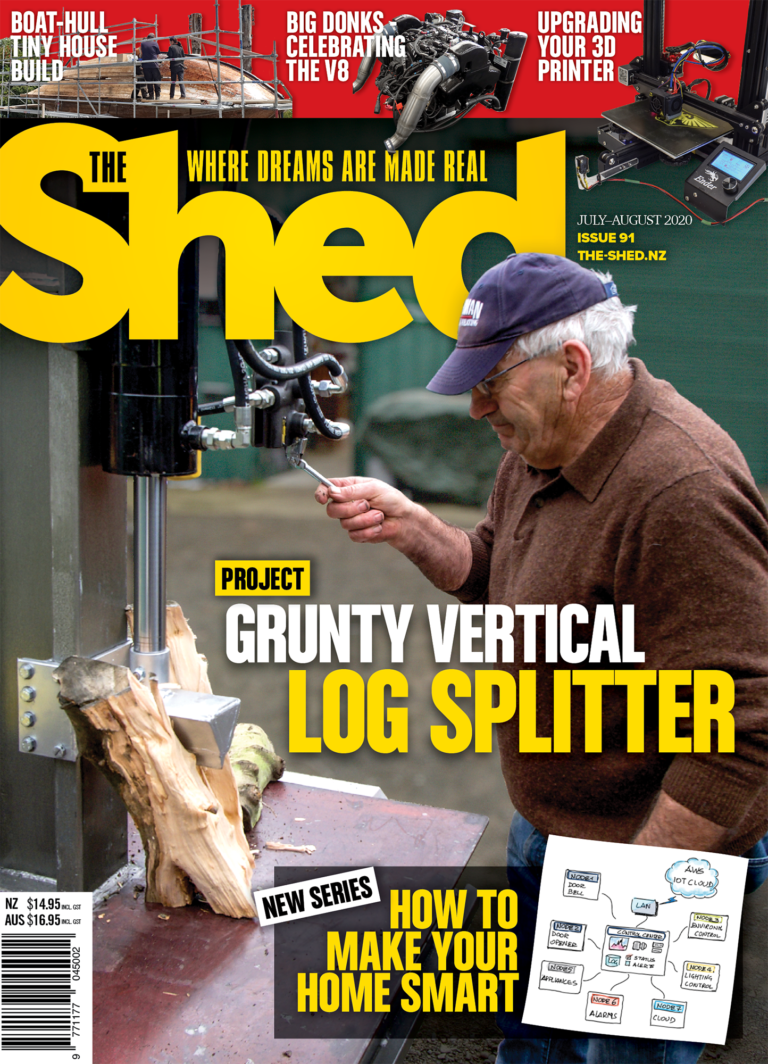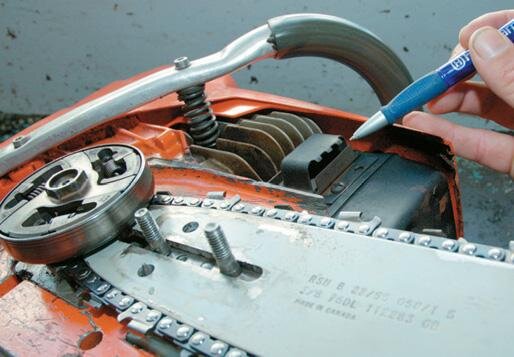The basics of a safe, functional log splitter
At CC Hydraulics, we do not build log splitters. In fact, we do not design log splitters or profess to be experts as there are excellent commercial log splitters builders and experts around. But we sell plenty of hydraulic equipment to people who design and build their own log splitters and through doing this well, we have gained a lot of knowledge about what works and what doesn’t. Believe me, there is a huge amount of misinformation out there.
Basics
The two areas we are asked the most about, when specifying the hydraulics, are speed and power. The four basics of hydraulics are: 1. flow (which gives the speed); 2. pressure (which contributes to the force); 3. horsepower (which dictates the flow and pressure); and 4. a hydraulic cylinder (most important component). The diameter of this cylinder with the pressure of the system (set by the main relief valve) is what gives us the final force of the log splitter in tonnes, not the size of the pump as so many people will argue. It is wrong to say the biggest pump makes for a super-fast log splitter. The bigger the gear pump, the less pressure it is able to handle. Log splitters are all about force and speed. Force comes from pressure, in combination with the actuator (cylinder) and speed from flow.
Planning
This project is not about building the ultimate log splitter but uses the basics of what a log splitter used to be: a beam with a hydraulic cylinder attached to force an axe-head through the log. Splitter gurus will argue about the merits of their different log splitters but I believe the vertical table splitter is the most practical. To build a log splitter, where do you start? Is it for commercial use or just the occasional weekend job? Do you already have a lot of components lying around? Unless you have a large budget, there will always be a need to compromise somewhere.
Power
I decided the cheapest power source was going to be something around the 7 HP pull-start which dictated that the pump would be a 50-ltr hi-low pump (log splitter pumps are specified as total flow at 3600 rpm). These pumps are also rated as 200 bar pressure.
Pump
To keep things simple for this project, I will consider using only a positive displacement gear pump. For every single rotation of the pump, a volume of oil will be displaced from the suction side to the outlet side of the pump. This volume is dictated by the physical size and design of the pump and is given as cc/rev. From this, you can see the faster you turn the pump shaft or the bigger the pump, the more oil will flow. All this assumes that pumps are 100 percent efficient. They never are so around 90 percent is normal in calculations. Pumps also have a limited speed range they can work in— the bigger the pump, the slower their maximum speed.
Oil tank and axle
The next decision was oil tank, the most understated part of a hydraulic system. With a 50 ltr hi-low pump I would still like to have around 60 litres of oil, but many customers are using a lot less with no problems. I decided the easiest way was to incorporate the tank in the axle. For this I used a piece of rectangular hollow section (RHS) steel 200 x 200 x 6 mm that was 1100 mm long. The ends were capped off with 183 x 183 x 16 mm plate in which I machined a 3 mm deep recess to locate the wheel stub assemblies I made. I drilled holes and welded black sockets in for a oil drain, oil pickup, filler/breather and oil return (via filter). IMPORTANT tips on oil tank design: • large surface areas are good for heat dispersion; • always have the return oil returning into the oil (notice we have put a dropper pipe inside the tank); • never put the oil pickup in close proximity to the oil return; • as some designers do, you can put baffles between the pickup and return.
Tank inspection
I hate to point out the obvious, but you will notice that I have no lid or large inspection plates. Normally, I believe every good oil tank should have some way of getting inside for cleaning and servicing. In a perfect world, there should be no reason to want to get inside, because I kept everything sealed through the whole process and thoroughly cleaned the inside before welding on the end plates. There is also a return filter, so providing everything is kept clean and you use new, good-quality oil, there should be no reason to look inside the tank. An astute reader will have noticed we will only have 38 litres of oil. I am comfortable with this for this particular project. With the axle/oil tank basically completed, it was sealed and put aside.
Main beam
For the main knife beam, I had some 250 mm Universal Column (UC) steel lying around so this was the obvious choice. I had a piece of 25 mm plate profiled 500 mm x 160 and fully welded this to one end of the UC. I cut two pieces of 150 x 90 x 10 mm angle iron and tack-welded it underneath the top flange to stiffen up the knife-track area. I used a cut-off disc to trim the excess width from the top flange. I then fully welded each end of the angle and stitchwelded down the length. A quick dress-up of the edges of the flange with a flip disc created a smooth edge for the knife gibs.
Pivot points
Because I am building a splitter that works both horizontally and vertically, I needed some more measurements to locate the pivot points accurately. I fully assembled the axle/tank with the wheels, then mounted a 65 x 65 x 5 mm RHS box section two-metres long centrally and at right angles to the tank. For the initial setup, I left an overhang approximately 400 mm wide at the rear and used four tack-welds to temporarily hold it there. Using a 50 mm hole saw, I cut a hole 50 mm in from the back of the drawbar and welded in a boss 75 mm long, with a 50 mm OD and 26 mm inside diameter. This is the rear pivot point.
Drawbar
I then temporarily clamped the front landing leg onto the front of the drawbar and levelled everything up. I fabricated the brackets for the rear prop from 4 mm plate and the prop itself from 50 x 50 mm RHS with a 100 x 100 x 4 mm foot on it. To align everything, I assembled the leg into the brackets then welded the brackets flush with the end of the drawbar. This prop was kept in the down position for the rest of the build for safety reasons. With the drawbar axle-assembly now parallel to the ground and secure, I bolted the two pivot lugs to the drawbar using a one-inch x 140 mm long bolt and nut. I then brought the main beam (standing vertical on the anvil) up to these lugs and put four good tack welds on one lug only. The reason for this will be evident when you bring the beam over to rest parallel onto the drawbar. If by any chance the main beam isn’t sitting at the dead centre of the drawbar because you have tacked only one bracket on, it is not a major to make the necessary adjustments. Another tip is to put two washers between the brackets and the boss in the drawbar; this gives some tolerance for shrinkage after welding. When you are happy with the alignment, tack-weld both brackets.
Hold-down
pin For the hold-down pin, measure along the drawbar 860 mm from the center of the pivot and bore another 50 mm hole and weld in another 75 mm long boss. Place the two brackets either side of the boss with a thin packing washer in between. Rest the main beam on these brackets and tack-weld together. The last thing to do before taking the main beam off is to find a suitable piece of steel to act as a spacer for the beam to sit on so that you don’t have to fight with the weight of the beam when you are trying to get the pin in. I used a piece of 50 x 25 mm RHS welded to the beam. The beam can be removed and all the brackets fully welded. When everything has cooled down, assemble back onto the drawbar.
Knife
Next, the knife (refer to the cutting drawing). The actual blade is BIS80 and all other parts mild steel. Before assembling and welding, I drilled and tapped 10 x M12 holes 15 mm in from each side of the 16 mm base plate and drilled 12.5 mm matching holes on the bottom clamps. Set the back plate onto the base plate at right angles and centre. Tack weld. Place the BIS80 plate centre down the length of the base and central to the back and tack weld. Before fully welding, pre-heat the BIS80 enough to take the chill out. When this had cooled down enough to handle, I fitted the two side plates to form the wedge and placed the two top plates in and fully welded them. The two cylinder-mounting lugs were then welded on the centreline of the complete knife assembly which also includes the 6 mm wear pad. The knife assembly can now be set up on the beam.
Mounting cylinder
Sit the wear pad down first and the knife on top. I then used four C-clamps and sandwiched the nylon gibs bottom wearstrip and bottom clamp together. Then through the top I drilled holes through the three plastic strips. Remove the clamps and drill all the holes to 12.5 mm. You can then reassemble using four bolts in each corner. My nylon gibs started out at 25 mm thick and by the time I had the knife assembly at a tight, sliding fit they were 21 mm. Just use a wood thicknesser to machine these. With the knife now sitting in place, mount the hydraulic cylinder’s top eye (shaft end) to the mounting lugs with a suitable pin. Fully extend the cylinder and then move the whole assembly forward until the knife clears the anvil by 5 mm. This now determines where the beam will be cut off and the rear mounts welded to. This measurement relates to the type of cylinder and the amount of stroke you have. In my example we have a 400 mm stroke and using our standard cylinder, this measurement is 1365 mm. To find this measurement exact, I went to the trouble of actually setting the cylinder up with a pin through the rear mounts and clamping the assembly to the beam. It was only then a matter of marking it and cutting. The rearmount plates were then all welded on. I machined up two high-tensile pins, welded them to the fish eyes and we were almost there.
Safety guard
I decided to add some sort of safety guard to protect the operator from getting a hand crushed if a log jammed on the knife on the return stroke. I had some profiles cut out of 10 mm plate to clear around the knife. This was welded on 400 mm from the inside edge of the anvil. A 60 x 10 mm stiffener was then added for extra strength. Two wings 200 mm x 5 mm thick were welded to the guard and anvil . These act like a pair of extra hands when handling some more awkward rings.
Valve
To hold the valve, I used a piece of 50 x 50 x 3 RHS, 480 mm long, with the ends cut at approximately 20 degrees. The location is a personal choice because everyone seems to use the splitter a different way. Because I am right-handed and will be using the splitter in the horizontal position most of the time, I decided to mount the valve on the right-hand side (looking forward from the anvil) and 650 mm back. I made up a mounting plate to suit the type of valve I was using and welded this to the top. This completes the main splitter assembly.
Mudguards
For the mudguards, I used mild steel 3 mm x 200 mm x 1040 mm long. The inside piece is 180 mm high x 600 mm long. The diagonal pieces cut from the corners of the back were used for the gussets. You may need different dimensions depending on your wheel and tyre sizes. I have used 13” heavy-duty, low-profile tyres. The two light surrounds were fabricated with some 3 mm off cuts, with the righthand one having a slot in the top for the number plate light to shine through. The plate is mounted vertically on the guard above it.
Power unit
With the guards on, this just about completes the main fabrication, so I was able to find a good location for the hydraulic power unit and the 7 Hp motor. The motor you are using will dictate exactly what your mounting plate will look like. I have got a 250 x 250 x 6 mm top plate with both sides folded down 180 mm and trimmed off diagonally. This is fully welded to the oil tank and then drilled to suit the motor mounts.
Towbar
For the towbar coupling I had a piece of 16 mm plate measuring 270 x 95 mm. This was drilled for the coupling and welded onto the drawbar. With the fabrication finished, establishing the final balance for towing and handling is a two-person job. Get someone to hold down the front of the drawbar while you raise the rear prop. I found that the rear was a lot heavier than the front. So after blocking the axle and wheels, I cut through the four drawbar tacks and moved the whole drawbar forward (with main splitting assembly attached) until I had approximately 25 kgs weight on the front. I used a fish springscale to confirm this. I then checked that the assembly was still square and central on the axle and fully welded it on. The fabrication complete, I dismantled everything and went over all the edges and welds with a flap disc to remove sharp edges and spatter. Everything was paint-prepped, primed and final-coated.
Testing
With all the assembly finished, the paint dry and the power pack bolted on, it was only a matter of fitting the hydraulic hoses, filling the oil tank up with 46 weight hydraulic oil and trying it out. I always fit a test gauge to the pressure circuit to confirm the relief valve is set correctly and doing its job. In this case, the relief and the kick-out adjustment was set far too high so they were both backed off until everything was operating smoothly.
Important: Rating
How are log splitters rated? This is the biggest argument I come across. Commercially built log splitters have all sorts of tonne ratings printed on the cylinder, even up to 55 tonne. But from the size of the cylinder and type of pump, the maths show it is impossible to achieve these figures. The clever marketing people have found a way of figuring out the (theoretical force) at the tip of the knife. This formula uses the length and angle of the knife to find an algebraic solution and then multiply this by the true force of the cylinder. I believe the only true way to rate the force is by going back to basic physics, i.e. area x pressure = force. This way, it comes down to the size of the cylinder and how much pressure is going in.
Admissions
1. In the text referring to the manufacture of the rear prop, I said that it was the first thing I did before proceeding with the knife etc. This is not true. The rear prop was one of the last things I made (because it was not in my initial design) but I found two things happened without the prop:
• I needed to block the axle to stop the whole assembly tipping up all the time—there were a couple of instances where the whole lot toppled over;
• when rotating the splitting assembly over to vertical, if the drawbar wasn’t held down, it tipped up, so I figured if I built this again the prop would be the first thing to build.
2. The other thing is, I made the anvil out of 25 mm mild steel. When I tested the splitter, everything was OK until I decided to test to the extreme and raised the pressure to max and split some 150 x 50 mm wood on its edge at the top of the anvil. It didn’t like it and subsequently bent. Two lines of thought. I was told that this should have been minimum 30 mm high tensile, but one hire centre I spoke to said that he has had the high-tensile plates break off around the welds. To me the obvious thing was then to leave the 25 mm mild steel plate on, and to weld another 25 mm high tensile plate to the back of it. This has worked spot on and I guess only time will tell.



